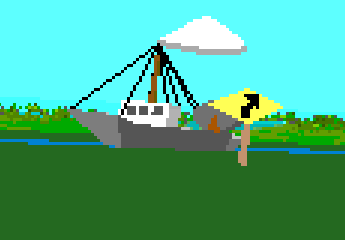Turning sign

While driving, turning signs are occasionally seen before open corners, though not always. It is not possible force a corner to have or not have one such sign; in fact, Stunts automatically calculates and decides whether a sign should be rendered at a certain location. This article describes the research on how this work and how it may be of use, despite the apparent insignificance of this detail.
Conditions for sign rendering
A research made by Cas yield the following rules for sign rendering:
- Stunts places corner signs only before open corners and open splits, but not before banked or elevated corners. All three materials work. The sign is placed shortly after the beginning of the previous tile (at about 1/20th of the way).
- The previous tile doesn't have to be an empty path. It could also be a crossway, a slalom or even a ramp. The end of a boulevard also works. Some tiles can't have the sign, but not because of incompatibility with it, but before of the following rule:
- The sign is only placed if there is a straightway four or more tiles long before the corner. Some tiles are not considered straightways, so they break the count and you have to start counting again from one after them. These include the tunnel, all corners (of course), the open split (though notably not the closed split) and all objects that are larger than one tile with the notable exception of up/down corkscrews.
- The start/finish line does count as straightway, but if it is located in the middle of a longer straigthway, only the tiles starting from the start/finish line itself will count.
- In the event that the sign is to be placed at a ramp tile, it is rised to the height of the ramp at that point and it is brought immediately by the road instead of separated and on the grass as it happens with other tiles. This ensures it's visible. In all cases, it's placed on the right side of the road.
- Stunts considers in which direction the road will be driven when placing signs. This means that the path tree must be resolved before deciding on where to place signs. As a consequence, disconnected roads and unresolved paths will not spawn signs.
- If an external editor is used to place a road directly on water, then signs will be rendered on water just the same as they do on grass.
- If the sign is to be populated on a slope, it does, both going up or down, even though going down, it doesn't help much and may not be noticed.
Applications
While corner signs don't normally make much difference while racing (they don't even slow the car down, it seems), one may just want a corner to be at a certain spot just to make the track look cool or to have fun breaking it. But there are some other possibilities that could make more sense.
The way in which Stunts decides where signs are placed is very particular and it'd be surprising that a routine had been specifically designed to make this useless decision. Therefore, one should assume other aspects of track rendering and possibly path analysis might be related to this process. For instance, the way Stunts picks the location of the cameras that are used in F4 view is likely to have something in common with this. Also, when two paths have the same length, it is not completely clear which is chosen by the opponent. Because signs are placed following a procedure that depends on path analysis, it is to be expected that it could provide a hint on which path would be taken by the opponent as well.
In the event one may wish to create a high resolution 3D track renderer or otherwise issue a faithful representation of the track or part of it, it could be relevant to know whether a sign is to be rendered and where.
Links
This is a forum topic created by Cas about this research here: [1]
